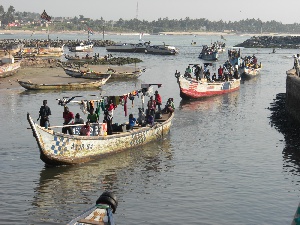Aquaculture or fish farming is anticipated to provide close to two thirds of global food consumption by 2030, as catches from wild capture fisheries level and demand from an emerging global middle class substantially continue to be uncertain.
These are among key findings of “Fish to 2030: Prospects for Fisheries and Aquaculture,” a collaboration between the World Bank, Food and Agriculture Organization of the United Nations (FAO) and the International Food Policy Research Institute (IFPRI), released on Wednesday.
The report which was made available to the Ghana News Agency by Tina Farmer, FAO Information Officer, Fisheries and Aquaculture in Rome, Italy, which highlights the extent of global trade in seafood which tends to flow heavily from developing countries to developed ones.
According to FAO, at present, 38 per cent of all fish produced in the world was exported and in value terms, over two thirds of fishery exports by developing countries were directed to developed countries.
The “Fish to 2030” report finds that a major and growing market for fish is coming from China, which is projected to account for 38 per cent of global consumption of fish food by 2030.
It said China and many other nations are increasing their investments in aquaculture to help meet this growing demand.
It added that Asia, including South Asia, South-East Asia, China and Japan, is projected to make up 70 per cent of global fish consumption by 2030.
The report said Sub-Saharan Africa, on the other hand, is expected to see a per capita fish consumption decline of one per cent per year, from 2010 to 2030, but due to rapid population growth of 2.3 per cent in the same period, the region’s total fish consumption would grow by 30 per cent overall.
The report predicts that 62 per cent of food fish would come from aquaculture by 2030 with the fastest supply growth likely to come from tilapia, carp, and catfish.
It said global tilapia production was expected to almost double from 4.3 million tons to 7.3 million tons a year between 2010 and 2030.
“The fast-moving nature of aquaculture is what made this a particularly challenging sector to model - and at the same time, embodies the most exciting aspect of it, in terms of future prospects for transformation and technological change,” said one of the report’s authors, Siwa Msangi of IFPRI.
The World Bank’s Director of Agriculture and Environmental Services, Juergen Voegele, said the report provides valuable information for developing countries interested in growing their economies through sustainable fish production, though he warns that carefully thought out policies are needed, to ensure the resource is sustainably managed.
The report said fisheries and aquaculture are a vital source of jobs, nutritious food and economic opportunities, especially for small-scale fishing communities.
It noted however, that threats from large-scale disease outbreaks in aquaculture and climate change-related impacts could dramatically alter this.
Árni M. Mathiesen, Assistant Director-General of FAO’s Fisheries and Aquaculture Department, emphasized that unlocking the potential of aquaculture could have long-lasting and positive benefits.
Business News of Friday, 7 February 2014
Source: GNA

















